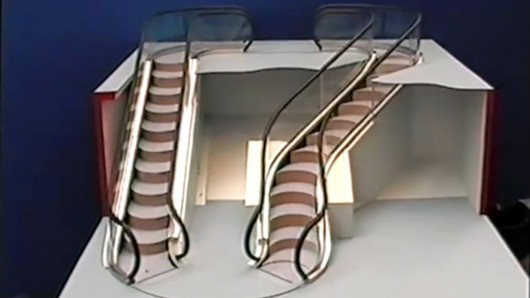An elegant, simple and brilliant innovation . . .
For over a century, escalators have followed a fairly straight path – with the exception of a few spiral and curved escalators found in cities including Reno and Osaka. Now a researcher at City University London has developed a new type of escalator called the Levytator that is capable of following freeform curves. This is achieved by replacing the traditional rectangular steps with curved modules that also allows the modules to be placed in a continuous loop. Not only does this open up the design possibilities for architects, it could also cut energy usage in half compared to conventional escalators.
Conventional escalators see redundant steps moving underneath those in use and require two separate escalators powered by two separate motors to carry passengers both up and down. Through the use of curved modules as steps, the Levytator, designed by Jack Levy, an Emeritus Professor of Mechanical Engineering at City University London, can be used in a continuous loop – following a curved path upwards, flattening and straightening out, before descending again. This means only one power source is required to carry passengers both up and down. Additionally, the weight of passengers traveling down can be used to offset the weight of passengers traveling up to further enhance energy savings.
As a result of mathematical modeling of the concept conducted with fellow University researcher, Elena Shcherbakova, Levy predicts that a fully-loaded Levytator with the maximum number of passengers traveling up and down would use around 80 percent of the power of two traditional escalators making the same trips. Meanwhile, a half-loaded Levytator with the down path full and the up path empty would use half the energy of the two equivalent escalators.
“The Levytator was primarily developed to give architects the ability to create escalators in any shape they want, but we’ve now shown that the design could significantly cut power consumption too. As utility bills rise and more organizations strive for green accreditation for their premises, we hope the Levytator can play an important role in cutting both energy use and the associated costs,” says Levy.
But the advantages of the Levytator don’t stop at aesthetics and energy savings. Because the curved modules are always “on top” and all the steps can be accessed from above, maintenance is much easier. Additionally, as no excavation is required for installation, the Levytator could be placed on top of an existing staircase.
“This could be particularly useful in the heritage sector, where the system could be placed on top of a grand staircase in a listed stately home, providing better access for elderly and disabled visitors, but not destroying the fabric of the building,” points out Levy.
Bookmark this page for “energy-saving escalator” and check back regularly as these articles update on a very frequent basis. The view is set to “news”. Try clicking on “video” and “2” for more articles.









